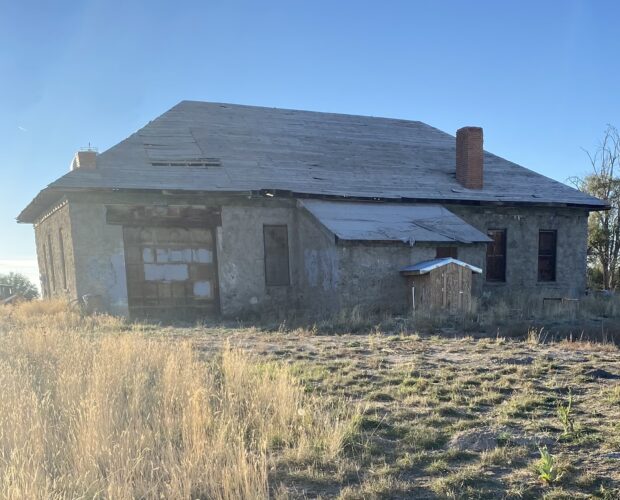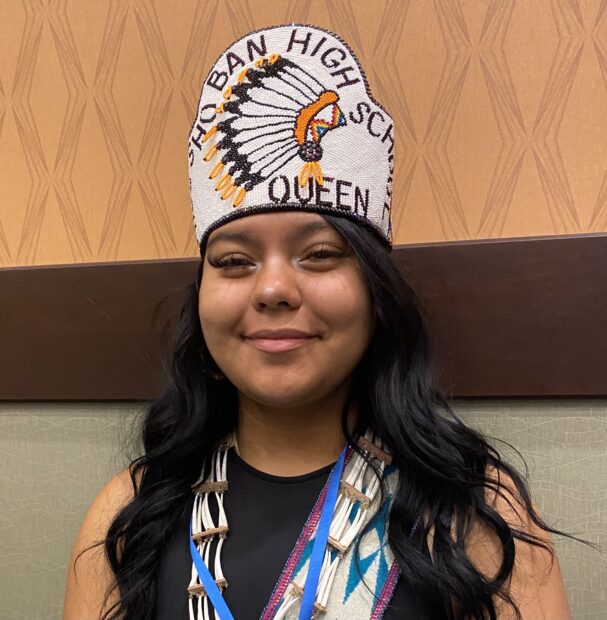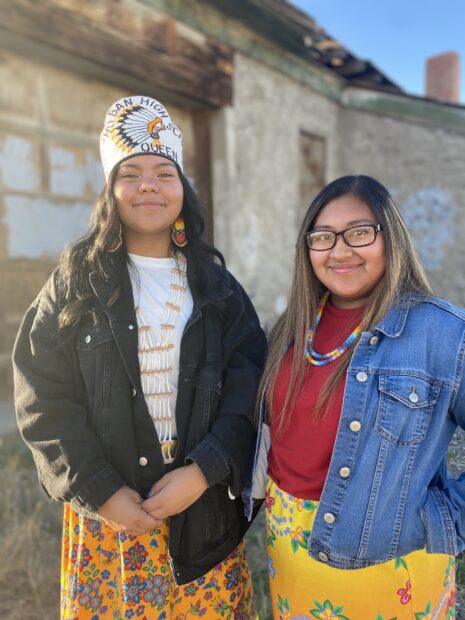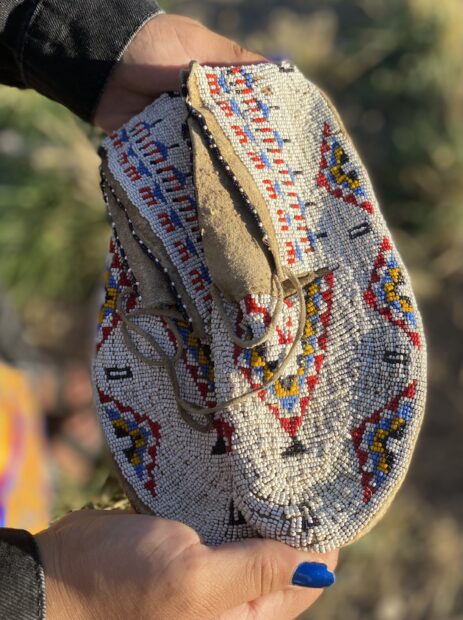FORT HALL – The late Agnes Lavatta rarely spoke about her time at the Fort Hall Boarding School.
Her silence and anxious handwringing when the topic came up said plenty.
Today, a chimney and a few dilapidated buildings with boarded windows are all that remains on that school campus, where hundreds of Native American children lived in the early 1900s after being forcibly removed from their homes.
Lavatta’s great-granddaughter, Teagan Larkin, stood at the school site recently, talking about her family history as pigeons flew in and out of an abandoned building.

Larkin’s own Shoshone-Bannock Jr./Sr. High School is within view from the old boarding school site, but still, some students and community members don’t know or talk about what happened there.
Larkin is on a mission to change that.
“It’s important to acknowledge the pain that came from (the past), but learn to heal from it – and not focus on the sadness but the success that can come from it,” she said.
The high school student is an up-and-coming leader in her community and this year’s Miss Sho-Ban High School queen. She plans to use that platform and her senior project to raise awareness about the history of boarding schools and help community members heal from intergenerational trauma in healthy ways.

The history she hopes to shine a light on is one of suppressed languages and cultures and separated families – but also one of the Shoshone-Bannock tribes’ resilience and strength.
A school that led to ‘unimaginable loss’
In 1904, the federal government opened what came to be known as “The Big School,” a campus that eventually housed 11 buildings, including dorms, a school, employee living quarters and a dining hall.
Many Shoshone-Bannock children were pulled from their homes on the reservation and forced to attend the school. Others were orphans or came from poor families who sent their children to the school to ensure they were fed.
A display at the Shoshone-Bannock Tribal Museum offers a glimpse into what life was like there:
“(Students) were punished for speaking their native languages and forced to attend church services. Elders said that when they were caught speaking their languages that their mouths would be washed out with soap. Some ran away but once caught were brought back and locked up in a dark room under the school. When segregation didn’t work, some were tied to a chair and whipped with a piece of rubber hose; some of the boys were dressed in girls’ clothing and paraded in front of all the students. Punishment was done in front of everyone … Children endured segregation, whipping, humiliation, and loneliness. They were not nurtured and loved as most children are; some did not survive this treatment and died there. Parents endured unimaginable loss when their children were taken and never seen again.”
The U.S. government partially funded the campus by selling off parts of the original Fort Hall Indian Reservation near Pocatello for homesteads — one of a number of government takeovers of reservation land. What started as a 1.8 million-acre reservation is today a third of the size at 544,000 acres.
By 1935, more than 200 students from the Fort Hall and Rocky Boy reservations attended the school, which closed in June of that year. In later years, the school was used to detain German prisoners of war.
Eventually, the buildings went unused and in 1962, the U.S. government demolished most of them. Today, all that remain are the laundry building, a pump house, a barn, an employee house, a water tower, and an orchard.
“There are people living today who attended the ‘Big School’ as they like to call it,” Ellen Dixey Ball wrote in a display she created for the Shoshone-Bannock Museum. “Many memories both good and bad are recalled by them. We are grateful to their contribution to our knowledge of the school.”
And it’s that knowledge that Larkin wants to keep alive.
‘Culture is who we are’
One way she plans to raise awareness about boarding schools is by holding a community event as part of her senior project on Feb. 22 – Ash Wednesday – a date she chose to “acknowledge the colonization that came with Christianity.”
At the event, Larkin plans to speak about the Fort Hall Boarding School and acknowledge the trauma it brought. A common goal of such schools was: “Kill the Indian, save the man.”
Larkin said the statement represents an impossibility – culture and identity are essential to livelihood.
For that reason, she also plans to use the community event to host cultural activities, like tying tobacco, making ribbon dresses and skirts, and making willow boards.
“Culture is who we are, so it’s important to relearn,” she said.
Plus, reengaging in traditions would help community members improve their mental health.
“When people think of reservations, they think of alcoholism and substance abuse and poverty and domestic violence,” Larkin said. “They don’t understand that that came from mental health issues, from unhealthy coping mechanisms, and from colonization.”
Larkin’s sister, Akaila Martin, is a suicide prevention clinician for the Shoshone-Bannock tribes. She acknowledged the need for more healthy outlets and said Larkin’s project would be a good way to introduce more options to the community.

“(The project) will help our people and that’s what we’re here for,” Martin said.
Laurel Tomin, an English teacher and the senior project advisor at Sho-Ban High, said the project entails a research paper, presentation before an adult audience, and a real-world project. Larkin has been thrilled about the community involvement portion, Tomin said.
“Her goals and her future are focused on helping others,” Tomin said. “That is just truly who she is. She reaches for those extra challenges above and beyond the expectations.”
It’s something Larkin said she learned from the women in her life.
Larkin hails from a long line of driven women
Larkin is inspired by the women who came before her: by her great-great-grandmother, Bessie Crow Lavatta, who was forced to walk hundreds of miles from Shoshone tribal lands near present-day Salmon, Idaho, to the Fort Hall reservation when she was only 5 years old; by her great-grandmother Agnes who was resilient enough to continue her education even after the traumas of the boarding school and who was Fort Hall’s first rodeo queen; by her mother, who has a passion for helping others. And by her sister.
“I am where I am because of the women who’ve helped me,” Larkin said.

In turn, she said she wants to be an “auntie” or second mom and role model for the next generation of Shoshone-Bannock youth. But her desire to help others doesn’t stop there.
“I don’t want to only help students or adults, I want to help families,” Larkin said.
Larkin has long-term plans to give back to her community. She will attend Idaho State University next year and major in marketing, minor in traditional parenting, and get an associate’s degree in Shoshoni. Afterward, she plans to open a nonprofit called “OURS” that will continue the work her senior project starts – helping Shoshone-Bannock people connect to their culture and establish healthy coping mechanisms.
And she’s reaching out to the public in another way, too. Larkin will be featured in a project called Native Voices in Idaho – curriculum designed to get Native American perspectives, history, and culture into the classroom.
Native Voices project highlights tribal teens
Larkin is among a handful of tribal youth who were chosen to be featured in videos talking about themselves and their culture. The videos will be part of a second installation of Native Voices curriculum that will become available in December.
“University systems do a cursory job of teaching about Indigenous people, there are few resources out there, and this curriculum … is written by Indigenous teachers and educators,” Antoinette Cavanaugh, a Native Voices in Idaho board member, said of the need for the project.
Larkin was selected in part because of her knowledge of her history and the Shoshoni language.
“She understands the traditional lifeways of the Shoshone and the Bannock people and that is an important piece … not only as a young Indigenous woman but also as an up-and-coming leader,” Cavanaugh said.
Cavanaugh is a former superintendent of the Elko County School District in Nevada and recently completed a 500-mile walk across Europe to raise awareness about the impacts of boarding schools on Native American children and their families. She and Larkin share a passion for making sure the past is not forgotten.
As Tomin said: “Teagan’s had her heart in history.”
